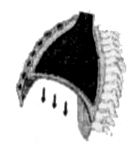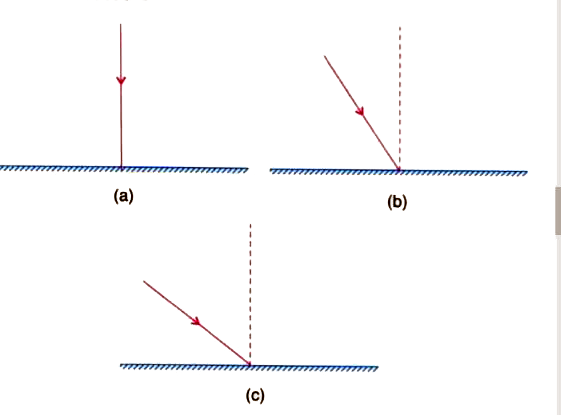Explain the following terms:
angle of incidence and
Draw diagram/diagrams to show them.
Step-by-Step Solution
1. Definition of Angle of Incidence:
- The angle of incidence is defined as the angle formed between the incident ray and the normal line at the point of incidence on a reflecting surface.
2. Understanding the Normal:
- The normal is an imaginary line that is perpendicular (at a 90-degree angle) to the surface at the point where the incident ray strikes.
3. Identifying the Incident Ray:
- The incident ray is the incoming ray of light that strikes the surface. It is usually denoted by the letter "I".
4. Drawing the Diagram:
- To illustrate the angle of incidence, you can draw a horizontal line representing the reflecting surface.
- Draw a vertical line from the surface at the point of incidence to represent the normal.
- Draw the incident ray approaching the surface at an angle to the normal.
- Label the angle between the incident ray and the normal as "I" (the angle of incidence).
5. Labeling the Diagram:
- Clearly label the incident ray, the normal line, and the angle of incidence in your diagram.
Diagram Description
- Surface: A straight horizontal line.
- Normal: A vertical line drawn perpendicular to the surface at the point of incidence.
- Incident Ray: A line approaching the surface at an angle, intersecting the normal.
- Angle of Incidence (I): The angle formed between the incident ray and the normal.
- The angle of incidence is defined as the angle formed between the incident ray and the normal line at the point of incidence on a reflecting surface.
- The normal is an imaginary line that is perpendicular (at a 90-degree angle) to the surface at the point where the incident ray strikes.
- The incident ray is the incoming ray of light that strikes the surface. It is usually denoted by the letter "I".
- To illustrate the angle of incidence, you can draw a horizontal line representing the reflecting surface.
- Draw a vertical line from the surface at the point of incidence to represent the normal.
- Draw the incident ray approaching the surface at an angle to the normal.
- Label the angle between the incident ray and the normal as "I" (the angle of incidence).
- Clearly label the incident ray, the normal line, and the angle of incidence in your diagram.
- Surface: A straight horizontal line.
- Normal: A vertical line drawn perpendicular to the surface at the point of incidence.
- Incident Ray: A line approaching the surface at an angle, intersecting the normal.
- Angle of Incidence (I): The angle formed between the incident ray and the normal.
Topper's Solved these Questions
- REFLECTION OF LIGHTBook:ICSEChapter:REFLECTION OF LIGHTExercise:EXERCISE 7(B)
Explore 9 Videos
- REFLECTION OF LIGHTBook:ICSEChapter:REFLECTION OF LIGHTExercise:EXERCISE 7(C)
Explore 54 Videos
- REFLECTION OF LIGHTBook:ICSEChapter:REFLECTION OF LIGHTExercise:EXERCISE 7(C)
Explore 54 Videos
- PROPAGATION OF SOUND WAVES Book:ICSEChapter:PROPAGATION OF SOUND WAVES Exercise:EXERCISE -8(B) (Multiple choice type)
Explore 3 Videos
- SOUNDBook:ICSEChapter:SOUNDExercise:TOPIC 2 Infrasonic and Ultrasonic Waves ( 3 Marks Questions)
Explore 3 Videos
Similar Questions
Explain the following terms:
angle of reflection.
Draw diagram/diagrams to show them.
View SolutionExplain the following terms :
Angle of reflection
Draw diagram/diagrams to show them.
View SolutionExplain the following terms:
incident ray
Draw diagram/diagrams to show them.
View SolutionExplain the following terms:
reflected ray
Draw diagram/diagrams to show them.
View SolutionExplain the following terms:
plane mirror
Draw diagram/diagrams to show them.
View SolutionExplain the following terms :
Incident ray
View SolutionThe following diagram explains

View SolutionIn the following diagrams (Fig ), measure and write the angle of incidence and draw the reflected ray in each case.

View SolutionExplain the term critical angle with the aid of a labelled diagram.
View SolutionDraw diagrams to show the formation of beats?
View Solution